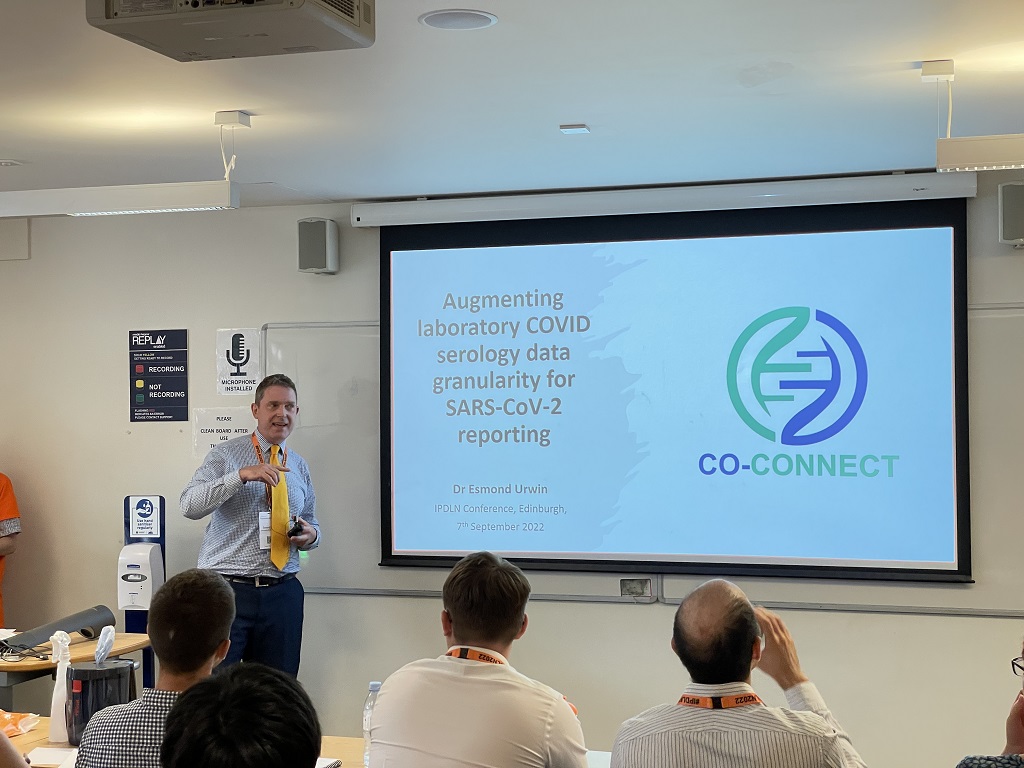What are CO-CONNECT's thoughts on: the 2022 IPDLN conference?
Work Package 2 Lead Esmond Urwin tells us about his experience presenting at the 2022 IPDLN conference in Edinburgh, Scotland.
By Gabriella Linning

The 2022 International Population Data Linkage Network (IPDLN) conference was recently held in Edinburgh, Scotland. Between the 7-9th of September, well over 400 people from around the world came together to present and discuss in-depth complex questions around data linkage.
During this event, five members of the CO-CONNECT team gave four unique presentations about or related to the project. A summary of all these presentations, and links to their abstract summaries, can be found in our news piece about the conference.
Esmond Urwin, from the University of Nottingham, was one of these team members. Esmond gave a presentation outlining why there should be a standard process by which serological data – that is, data collected from analysing blood serum – is collected and recorded, and how this could potentially be achieved.
He agreed to sit with me and tell me more about his experience.
In your own words, can you explain broadly what your presentation was about?
Jargon Buster
Serology is the scientific study or diagnostic examination of blood serum, especially with regard to the response of the immune system to pathogens or introduced substances.
You can find out more by visiting the following website: https://www.healthline.com/health/serology
Qualitative data isdata that cannot be objectively measured or counted, or data that is descriptive – it tells you about the ‘meaning’ or underlying qualities of an item or process. Qualitative data in statistics is also known as categorical data – data that can be arranged categorically based on the attributes and properties of a thing or a phenomenon.
In this case, data on COVID-19 test results are qualitative because even though you can count how many tests are positive, negative and indeterminate, in reality it doesn’t tell you much. It is categorical. How strong is the immune response? Which variant of the SARS-CoV-2 virus are people testing positive for? These are answers a simple count cannot help researchers determine on their own.
To find out more, visit the following website: https://www.questionpro.com/blog/qualitative-data/
Quantitative data is any data that has numerical properties. One of the most important functions of quantitative data is to answer questions like “How many?”, “How often?”, “How much?”. This data can be verified and conveniently evaluated using mathematical techniques. The only way to answer these questions is to collect data that is quantifiable, meaning it can be measured.
To find out more, visit the following website: https://www.questionpro.com/blog/qualitative-data/
The CO-CONNECT Work Package 2 presentation explained why a COVID serology (blood) data standard is needed and what it should look like. Currently, across the UK, public testing laboratories submit COVID serology results that contain qualitative test results – meaning are they positive, negative or indeterminate – but there is no standard reporting of quantitative results, like number results and data about antibody levels.
And so, why is developing a standard system for reporting and recording quantitative information important?
Positive and negative results (qualitative results) give a good indication of who has and does not have COVID antibodies, thus giving an understanding of levels of infection for a section of a population at that specific point in time. To better understand the characteristics of an infection and actual levels of antibodies, quantitative data is needed. With this quantitative data, antibody levels within a population can be analysed, this can then be used to determine: how outbreaks of COVID might affect people; how widespread more different mutations of the COVID virus might be; and in turn better define what can be done to counter such outbreaks
What does this standard look like? How did you and your team members go about making it?
We began by first collecting an initial set of data attributes collected from CO-CONNECT’s contributors – colleagues, data partners and so on. In total, we gathered 36 attributes that came together to create our first draft of our data standard. Of course, this is quite a lot, so the next task was to strip it back.
At first, we had a difficult time determining which of these original 36 were the ‘important’ attributes as they all seemed important to us. At least at first. Spending time understanding each of the attributes and using the knowledge gathered from existing healthcare data standards helped focus on what was actually important. This, and really thinking critically, focusing on which of the attributes would represent the ‘bare minimum’ – what is actually needed? – helped us to define the final 12 data attributes that make up our new standard for reporting COVID serological data.
We validated our work by collecting feedback from many of CO-CONNECT’s project partners, NHS laboratory technicians and the Work Package 2 members. together, they supported our work, proving that within the context of 3 NHS laboratory pilot studies, that the 12 attributes chosen were the correct ones.
Following on from this, further study of COVID serology studies nationally and worldwide proved that the chosen data standard attributes existed and were accounted for elsewhere in the world, further underlining the fact that these are representative and worthy of a COVID serology minimum data standard.
Summary of Esmond's work
Esmond and his team set about creating a standard practice guideline on how COVID serology data should be recorded across the UK. This is to help improve the collection of comparable, quantitative data which would help researchers to better understand the characteristics of an infection.
For example, how do the level of antibodies change through time after someone is infected with the SARS-CoV-2 virus? how long does it take for antibody levels to build up? how long do they last?
To do this, Esmond and his team brainstormed an initial list of 36 characteristics that all COVID serology recording processes should have. With further feedback, investigation and real-world testing, they were able to bring this down to a 12 point standard. A guideline outlining the bare minimum characteristics that should be incorporated into serological data recording across the UK.
What did your audience think about this idea? What types of questions did they ask? Were there any surprises?
Overall, I would say there were two veins of questioning. On the one hand, some audience members asked about the representation of assay and test kits, which are currently accommodated for within the standard. Then others focused on what it would take to make this a reality and bring it to life within the UK, to which the answer focused upon the funding of a worthwhile but time-consuming task. The variations between laboratory setups across the UK can differ quite a bit, hence the time and effort to assess each of those setups and enact the standardisation should not be underestimated.
Jargon Buster
An analysis that can qualitatively assess or quantitatively measure the presence or amount or the functional activity of a target entity, such as specific antibodies in the blood or a biochemical in a cell.
The set of guidelines Esmond and his colleagues worked to put together to be used as a measure, norm or model to help make COVID serological recording procedures comparable and consistent across the UK.
Interesting, could you expand on these issues a little bit more? Why were they of interest to the audience?
So, different laboratories record and structure COVID test data in different ways. Many of these laboratories may use the same methods for messaging and structuring for recording those results, but there are variations between them. Additionally, laboratories use different assays, test kits and laboratory machines, together with different laboratory software to record the data. Therefore, there are a multitude of variations throughout the testing process which can:
- make the data recorded seem different between laboratories, because it has been for example, been recorded using different words (from lab to lab), even though those words may mean the same thing;
- not enough explanation / definition is given about which laboratory machines and test kits are being used, together with the actual machine rules that define what is a positive or negative COVID serology test result.
What did other members of the CO-CONNECT team have to say about the conference?

“This was my first big post-COVID conference coming two years into the CO-CONNECT project. It was a great opportunity to meet people in person that I’d spent two years talking to on Teams. My talk on the different governance approaches to getting approval for federated data projects for both consented and unconsented data was well received with many follow up questions being asked.”


